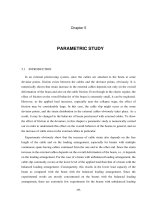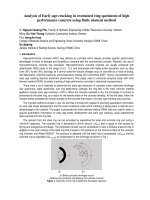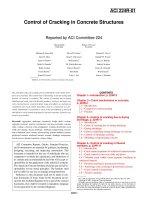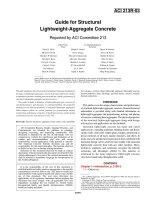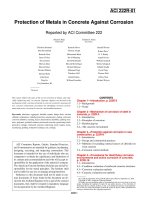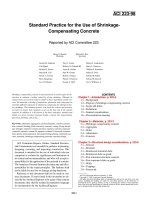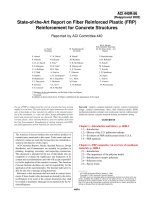Penetrability of lightweight aggregate concrete
Bạn đang xem bản rút gọn của tài liệu. Xem và tải ngay bản đầy đủ của tài liệu tại đây (2.17 MB, 180 trang )
Penetrability of Lightweight Aggregate Concrete
LIM EMIKO
2011
A THESIS SUBMITTED
FOR THE DEGREE OF MASTER OF ENGINEERING
DEPARTMENT OF CIVIL ENGINEERING
NATIONAL UNIVERSITY OF SINGAPORE
1
Acknowledgements
The author wishes to express her deep gratitude to her late supervisor, Associate
Professor Wee Tiong Huan as well as Associate Professor Ang Kok Keng under whose
supervision this research was performed.
The author would also like to express her sincere thanks and appreciation to her Cosupervisor Dr Tamilselvan s/o Thangayah for his assistance at all stages of the Master of
Engineering thesis. His invaluable guidance, advice and full support throughout the
course of this study is gratefully acknowledged.
Gratitude is also extended to all the technical staff of the Concrete and Structural
Engineering Laboratories, Department of Civil Engineering, The National University of
Singapore for their invaluable assistance in providing the necessary materials and
technical help to endure the successful completion of all laboratory experimental works.
Acknowledgement is also due to those who have in one way or another contributed to
this research and to authors of various papers and materials quoted in the references.
The author wishes to express her greatest gratitude to her beloved parents for their
invaluable love, support and encouragement.
2
Table of Contents
TITLE PAGE
i
ACKNOWLEDGEMENTS
ii
TABLE OF CONTENTS
iii
ABSTRACT
vii
NOMENCLATURE
ix
ABBREVIATIONS
xi
LIST OF FIGURES
xii
LIST OF TABLES
xiv
Chapter 1: Introduction
1.1
General background
15
1.2
Research objectives
21
1.3
Scope of work
22
1.4
Organization of dissertation
24
Chapter 2: Literature Review
2.1
Applications and history of concrete structures
25
2.2
Applications and history of lightweight aggregate concrete
27
2.3
Water and chloride transport mechanisms
29
2.4
Water Sorptivity
31
2.5
Chloride Diffusion
37
3
2.6
Water Permeability
39
2.7
Penetrability of concrete
41
2.8
Concrete deterioration in sea water
49
2.9
Water pressure on concrete structure
51
2.10
Swelling of concrete under water
52
2.11
Effect of temperature on concrete
53
2.12
Carbonation
55
2.13
Background of mineral admixture silica fume
57
2.14
Effects of silica fume
58
2.15
Recycled aggregates
59
2.16
Recycled aggregates classification
62
Chapter 3: Experimental Details
3.1
3.2
3.3
Materials
64
3.11
Cement
64
3.12
Natural aggregates
65
3.13
Lightweight aggregates
65
3.14
Recycled aggregates
67
Sample Preparations
69
3.2.1
Mix proportions
69
3.2.2
Sample preparations
75
Experimental Procedures
3.3.1
Water Sorptivity Test
77
4
3.3.2
Chloride Diffusion Test
80
3.3.3
Water Permeability Test
84
3.3.4
Chloride ingress test using a high pressure chamber
88
3.3.5
Carbonation Test
91
3.3.6
Chloride Profile Test
92
Chapter 4: Results and Discussion
4.1
Experimental results
93
4.2
Discussion on Penetrability of lightweight aggregate concrete
105
4.2.1 Effect of water-cement ratio
106
4.2.2 Effect of density
109
4.2.3 Effect of initial moisture content in LWA
110
4.2.4 Effect of LWA size
113
4.2.5 Effect of LWA volume
114
4.2.6 Effect of lightweight aggregate type
115
4.2.7 Effect of temperature
117
4.2.8 Effect of pressure
119
4.2.9 Effect of mineral admixture silica fume
121
4.2.10 Chloride profile results
121
4.3 Discussion of Recycled aggregate concrete based on Strength of concrete
123
4.3.1 Water sorptivity
123
4.3.2 Chloride ingress
123
4.3.3 Carbonation
127
5
Chapter 5: Conclusions
130
References
134
List of Publications
179
6
Abstract
A study on the parameters affecting the sorption of water, chloride ingress,
permeability of water and carbonation into lightweight aggregate concrete, normal weight
concrete and recycled aggregate concrete was carried out. The parameters being studied
are effect of water-cement ratio, aggregate type, initial moisture content of lightweight
aggregate, size of lightweight aggregate, density of lightweight aggregate, volume of
lightweight aggregate, varying temperatures of (1°C to 40°C), high pressure of 30MPa
and the mineral admixture silica fume. Experimental programme series were designed to
look into the effects of these parameters on the penetration of water and free chloride ions
into lightweight aggregate concrete by water sorption under capillary action in
unsaturated concrete, chloride diffusion under a constant concentration gradient, water
permeability under a constant pressure gradient and carbonation. From this research, it
was found that variations in water-cement ratio, size of lightweight aggregate, density of
lightweight aggregate and volume of lightweight aggregate has reasonable effects on
penetrability properties of lightweight aggregate concrete. The effect of initial moisture
content in lightweight aggregate on properties of lightweight aggregate concrete was not
obvious from this research. When comparing trends for normal weight granite concrete
and lightweight aggregate concrete (atmospheric pressure versus 30MPa pressure),
pressure did not have any significant effect on chloride ingress. The mineral admixture
silica fume at (10% replacement level to cement content), showed negligible effect in
reducing water sorptivity and chloride ingress and effect of temperature is more
7
significant at higher temperatures (> 30°C) as compared to lower temperatures (<20°C)
for chloride ingress into lightweight aggregate and normal weight concrete.
For recycled aggregate concrete, results show that increasing concrete strength for
higher grades G60 and G80 for replacement percentage of 20%, will decrease the
chloride diffusion depth. Trends of water absorption coincide with that of chloride
diffusion. However, results show that using a lower grade of concrete with a higher
replacement levels will increase the water absorption significantly. There is a resistance
to carbonation for higher strength recycled aggregate concrete. Carbonation depth was
reduced for the higher grades of concrete i.e: G60 and G80. Using lower grade concrete
with higher replacement percentage of 50% and 100% will increase the carbonation
penetration depth from 5.3-6.0%.
Keywords: Temperature; Pressure; Lightweight aggregate density; Lightweight
aggregate size; Water-cement ratio; Chloride; Water permeability; Water Sorption;
Chloride diffusion; Carbonation; Recycled lightweight aggregate concrete.
8
Nomenclature
∆H
drop in hydraulic head across the sample (m)
a
porosity
A
cross sectional area of flow (m2)
a‟
empirical constant (m)
A‟
constant (mm3/mm2)
C
concentration of chloride ions (kg/m3)
C(x,t)
chloride concentration at depth x (kg/m3)
C0
surface chloride concentration (kg/m3)
Dc
apparent diffusion coefficient (m2/s or m2/week)
Deff
effective diffusion coefficient (m2/s)
e
elemental charge
erf
error function
h
Boltzmann value
h
concentration in bulk electrolyte
I
cumulative volume of water absorbed per unit area of inflow
surface(mm3/mm2)
J
flux of chloride ions (kg/m2s)
K
capacitance on atomic scale
k
coefficient of water permeability (m/s)
L
thickness of specimen (m)
Q
flow rate (m3/s)
Sw
coefficient of water sorptivity mm/min 0.5
9
T
absolute temperature
t
exposure period (s, min or week)
T
time of test (s)
v
valency of ion
x
depth of penetration (m)
x
depth of penetration (m)
x
depth of Cl- penetration(m) obtained using the AgNo3 spray method
x‟
position variable (m)
ε
dielectric constant
10
Abbreviations
LWA
Lightweight aggregate
LWAC
Lightweight aggregate concrete
LWC
Lightweight concrete
NWA
Normal weight aggregate
NWC
Normal weight concrete
RCA
Recycled concrete aggregate
w/c
water-cement
11
List of Figures
Page
Figure 1.1:
Scope of research.
8
Figure 3.1:
Particle size distribution curves for recycled concrete aggregate
(RCA) and coarse aggregate (NA).
53
Figure 3.2:
Water sorptivity test set-up.
64
Figure 3.3:
Weighing machine used for water sorptivity testing.
64
Figure 3.4:
Splicing machine used for the chloride diffusion test.
67
Figure 3.5
Test specimens being submerged in sodium chloride
19380 ppm solution.
68
Figure 3.6
Cooler used to test for cool temperatures of 1ºC, 6 ºC and 12 ºC.
68
Figure 3.7:
28-day spliced chloride specimen after being sprayed with
silver nitrate solution.
69
Figure 3.9:
56-day chloride ingress penetration depth for normal weight
concrete and L800 lightweight aggregate concrete
test specimens.
Schematic presentation of water permeability test.
69
71
Figure 3.10:
Hyperbaric test specimen.
74
Figure 3.11:
Test specimens securely tied up.
74
Figure 3.12:
Interior of Hyperbaric test chamber.
75
Figure 3.8:
Figure: 3.13: Lid of 30MPa hyperbaric test chamber.
75
Figure 3.14:
Hyperbaric Chamber.
76
Figure.4.1:
Effect of w/c ratio on the water sorptivity coefficient (Sw).
90
Figure 4.2:
Effect of w/c ratio on the chloride diffusion (Dc) and the water
permeability coefficient (k).
90
Effect of initial LWA moisture content on the water
sorptivity coefficient (Sw).
94
Figure 4.3.:
12
Figure 4.4:
Effect of initial LWA moisture content on the chloride diffusion
coefficient (Dc).
94
Figure 4.5:
Chloride penetration depth versus temperature for Series F.
101
Figure 4.6:
Chloride penetration depth for Concrete type versus
pressure (MPa).
102
Figure 4.7:
28-day chloride profile test at 30MPa and 30°C.
104
Figure 4.8:
84-day chloride profile test at 0.1 MPa and at 30°C.
104
Figure 4.9:
Chloride penetration depth (mm) versus time (days) for
0% replacement level.
Figure 4.10:
Chloride penetration depth (mm) versus time (days) for
20% replacement level.
Figure 4.11:
108
Chloride penetration depth (mm) vs RCA replacement (%)
for G40 concrete.
Figure 4.13:
107
Chloride penetration depth (mm) vs RCA replacement (%)
for G30 Concrete.
Figure 4.12:
107
108
Chloride penetration depth (mm) vs RCA replacement (%)
for G50 concrete.
109
Figure 4.14:
Carbonation results for G50, G60 and G80 concrete specimens.
111
Figure 4.15:
Carbonation results for G30, G40 and G50 concrete specimens.
111
13
List of Tables
Page
Table 2.1:
Composition of sea and ocean waters.
34
Table 2.2:
Reference test method for recycled concrete aggregate.
44
Table 3.1:
Chemical composition and physical properties of ordinary
Portland Cement.
49
Table 3.2:
Grading of fine and normal weight coarse aggregates.
51
Table 3.3:
Physical properties of Leca aggregate.
51
Table 3.4:
Summary of comparison of physical properties of RCA and NA.
53
Table 3.5:
Mix Proportions of concrete samples.
54
Table 4.1:
Summary of penetrability properties and compressive strength.
79
Table 4.2:
Compressive strength of recycled aggregate concrete.
82
Table 4.3:
Summary of recycled concrete aggregate penetrability properties. 86
Table 4.4:
Summary of R2 Values
87
Table 4.5:
Summary of Penetrability of concrete from literature review.
90
14
Chapter 1
1.1 General Introduction
Floating concrete structures are prevalent in the marine industry. For such structures to be
able to float, mostly lightweight aggregates would be used in its mix design. The range of
applications of floating concrete structures is fairly large. It may include: oil exploration
and drilling platforms, oil production platforms, LPG terminals, barges, ships and yachts,
floating docks, floating gates for dry docks, floating airports, floating power stations,
ocean thermal energy convertor (OTEC) plants, rotating mooring structures, floating
hotels, floating shopping centres, floating industrial plants, floating jetties, floating
bridges, floating bridges piers, semi-submersible tunnels, floating lighthouses, floating
breakwaters, floating bridge girders, semi-submersible towns etc as reviewed by VSL
(1992). The use of lightweight aggregate concrete for some marine structures include: the
USS Selma, the ship Atlantus; a floating dock in Genoa Habour and an underwater oil
storage tank in 150m of water in the North Sea off the west coast of Scotland were stated
by Clark (1993).
According to Sea Temperature (2011), seawater temperature varies from 9.8 ºC for
countries in North America and Greenland, to 28.9 ºC for the Middle East. Subsea
temperatures can go to as low as 4 ºC and have subsea pressures of up to 4MPa. Though
LWAC has been used for a couple of decades all over the world, the factors that
influence the penetrability of LWAC, as well as the penetrability of LWAC under
pressure and varying temperatures for subsea conditions have not been well-established.
15
The durability of concrete for subsea structures is affected by some important factors:
water penetration, ingress of chloride ions into concrete, temperature of the seawater and
hydrostatic pressure due to the seawater. If water or chloride ions were to enter concrete
structures, corrosion of reinforcing steel bars, severe cracking and spalling of concrete
may occur. This would then compromise the load-bearing capacity of the marine
structures. Factors like chloride and water ingress into concrete can be further studied to
show that these factors are not detrimental when lightweight aggregate concrete is placed
in the marine environment for long periods of time. The effect of temperature and
pressure are important too as in the subsea environment, the underwater pressure exerted
on the concrete can be very high. So far Indian scientists Krishnamurthy and Kowadkar
(1981) have researched on the effect of pressures corresponding to submergence depths
up to 210m. Bijen and van der Wegen (1994) reported that concrete submerged in water
swells. The expansion is larger in seawater than in fresh water. Under high pressure the
swelling is larger and faster than under atmospheric pressure. Their tests were conducted
under exposure conditions of 10MPa and temperatures of 5 ºC, 20 ºC and 40 ºC. Also
seawater temperatures can vary from arctic water condition, to temperate conditions and
hot tropical middle-eastern seawater conditions. Haque and Al-Khaiat (1999) reported
that the water penetrability of total LWC was found to be higher than the NWC on
exposure to hot marine environment. Research results show that the higher the water
penetrability of a given concrete, the higher is the penetration of damaging agents like
carbon dioxide, sulphate and chloride ions into concrete. Furthermore, the depth of water
penetrability of a concrete can be used as in indicator of its durability (Haque and AlKhaiat, 1999, Al-Khaiat and Haque, 1999, Haque, et al, 2004) So far research data have
16
been inconclusive as to what would be the chloride ingress into normal weight and
lightweight aggregate concrete under high pressure and also different seawater
temperatures. Also there is so far insufficient research data on temperature as a factor
influencing penetrability of concrete for three different types of concretes: normal weight
granite concrete (NWC), lightweight aggregate concrete (LWAC) and recycled
aggregates concrete (RAC). Therefore in this study to contribute more data with
relevance to subsea structures, tests were conducted at 0.1MPa which is atmospheric
pressure, 30MPa which is considered the upper boundary of pressure and temperatures of
1, 6, 12, 30, 40ºC. As water freezes at 0ºC, 1ºC is taken to be the lower temperature
boundary and 40 ºC the upper temperature boundary in this study.
For LWAC concrete to be more extensively used in marine and offshore applications
there is a need for a better understanding of the penetrability of LWAC to water and free
chloride ions. While much research has been carried out on the penetrability of normalweight concrete (NWC), findings on the penetrability of LWAC has been scarce. One
reason could be that the performance of LWAC may be reasonably affected by the
characteristics of the lightweight aggregate (LWA) used, such as the type of LWA,
density of LWA, and preparation of LWA before casting. Such factors are generally not
considered in NWC. There are studies which suggest that LWAC has lower permeability
than NWC despite the more porous aggregates (Lydon, 1980, Holm et al, 1984, Zhang
and Gjørv, 1991, Chia and Zhang, 2002). However, the resistance of the LWAC to the
chloride penetration and its chloride diffusion coefficient were similar to that of NWC
with equal water to cement (w/c) ratio (Chia and Zhang, 2002, Sugiyama et al, 1996,
17
Chia, 2001). Gjørv et al (1994) examined the diffusivity of chlorides from seawater into
high-strength LWAC and found that the maximum LWA size had minor effects on
chloride diffusivity, while increasing the LWA density from 1.07 to 1.44 g/cm3 reduced
the diffusivity by a factor of about 2.
The use of recycled aggregates is now on the rise in Singapore. This is because the
average amount of construction and demolition (C&D) waste available for reuse is
estimated to be 2 million tons per year (BCA Sustainable Construction Series – 4, 2008).
The landfills used for disposal of C&D waste are being filled up rapidly due to limited
land area in Singapore. Therefore, it is necessary to find ways to solve this problem.
There will be less disposal problems if part of the C&D waste is recycled. The lack of
natural aggregates (NA) available in Singapore has also posed a need to source for
alternative materials to use in construction. Hence, using recycled concrete aggregate
(RCA) can save material cost since less natural aggregates will be needed for new
construction works. The Building and Construction Authority (BCA) have been working
closely with industry partners to promote wider adoption of sustainable materials in our
built environment. Therefore a study is also made in this research to compare the
penetrability of lightweight aggregate concrete and recycled aggregate concrete. The tests
to be carried out are for water sorptivity, chloride ingress and carbonation. These data
would be relevant to Singapore‟s green construction industry and the data for chloride
ingress would be useful to the marine industry. With the introduction of performancebased standards like SS EN 12620: Specification for Aggregates for Concrete, recycled
and manufactured aggregates can be adopted for a range of structural and non-structural
18
applications (BCA Sustainable Construction Series – 4, 2008). BCA urges all
stakeholders in the industry to make a concerted effort to adopt the use of recycled
materials in their building projects. It is also believed that with the greater use of recycled
materials, the industry will reach another significant milestone in contributing to a
sustainable built environment (BCA, 2008).
The adhering mortar on recycled granite is a weakness that is of concern when addressing
the penetrability of concrete. The use of recycled aggregates in structural applications is
limited due to the presence of adhering cementitious mortar on the individual recycled
aggregate particles. The adhering mortar has been reported to result in higher porosity,
higher water absorption, lower modulus of elasticity and weaker interfacial zone (ITZ)
between the newly cast cementitious mortar and the recycled aggregates, Ong (2008).
Therefore to encourage the use of recycled aggregate concrete in the construction
industry, it is of importance that we know how is the durability performance of recycled
aggregate concrete at different strength level and different replacement level. To test for
such durability issues, this study would test for water, chloride and carbonation ingress as
they are the more common durability problems.
This research makes a holistic study on the parameters affecting the penetrability of
normal weight granite concrete (NWC), lightweight aggregate concrete (LWAC) and
recycled aggregates concrete (RAC), where penetrability of concrete is attributed
primarily to permeability, diffusion, and sorption of fluids in concrete. LWA properties
that may potentially impact the overall concrete penetrability are taken into consideration.
19
1.2
Objectives
To study the factors influencing penetrability of concrete for three different types of
concretes: normal weight granite concrete (NWC), lightweight aggregate concrete
(LWAC) and recycled aggregates concrete (RAC). The penetrability of concrete would
encompass water sorption under capillary action in unsaturated concrete, chloride
diffusion under a constant concentration gradient, water permeability under a pressure
gradient and carbonation. Below is a list of factors to be studied:
1. Factors influencing water sorptivity at different temperatures (1, 6, 12, 30, 40ºC).
a) Types of concrete
b) Types of lightweight aggregate
c) Mineral admixture (silica fume)
d) Grade for recycled aggregate concrete
2. Factors influencing chloride ingress at different temperatures (1, 6, 12, 30, 40ºC).
e) Types of concrete
f) Types of lightweight aggregate
g) Mineral admixture (silica fume)
h) Grade for recycled aggregate concrete
3. Factors influencing chloride ingress due to pressure at room temperature (30ºC).
i) Types of concrete
j) Mineral admixture (silica fume)
20
4. Factors influencing permeability at room temperature (30ºC).
k) Types of aggregate
5. Factors influencing carbonation of recycled aggregate concrete (RAC) at room
temperature (30ºC).
l) Strength of concrete
1.3
Scope of work
a) To study the effect of temperature on water sorptivity and chloride ingress for lightweight
aggregate concrete, normal weight and recycled aggregate concrete.
b) To investigate the penetrability of LWAC to water and chloride in relation to physical
and geometrical properties of lightweight aggregate and different types of concrete.
c) To investigate the effect of chloride ingress and water sorptivity on recycled
aggregate concrete of varying strength grade (30MPa, 40MPa, 50MPa, 60MPa
and 80MPa) at varying temperatures of (1, 6, 12, 30, 40ºC).
d) To study the effect of high pressure (30MPa) on lightweight aggregate concrete
and normal weight concrete at room temperature with and without mineral
admixtures
e) To investigate the carbonation effect of recycled aggregate concrete of varying
strength grade (30MPa, 40MPa, 50MPa, 60MPa and 80MPa).
21
Scope of work (flowchart)
Penetrability of lightweight aggregate concrete
Recycled aggregate
concrete (30MPa,
40MPa, 50MPa, 60MPa
and 80MPa)
Normal weight concrete (NWC) and Lightweight Aggregate Concrete (LWAC)
Penetrability of LWAC
and NWC under pressure
At Pressure
of 30MPa
using
Hyberbaric
Chamber
At
Atmospheric
Pressure
Investigate the effect of
pressure on LWAC and
NWC:
a) Chloride
Diffusion Dc,
Water
Sorptivity
Test at
temperature
of 1ºC and
30 ºC
a) Investigate
sorption of
water into
unsaturated
LWAC
b) Obtain
water
sorptivity
coefficient,
Sw at 1 ºC
and 30 ºC.
Water
Permeability
Test
Chloride Diffusion
Test
(Long term)
At room
temperature
of 30ºC:
Obtain water
permeability
coefficient, k,
at 30 ºC.
At low
temperature
of 1ºC, 6ºC,
12ºC using
a chiller:
a) Investigate diffusion of free
chloride ions into saturated LWAC
under a concentration gradient.
At high
temperature
of 40 ºC
using a
heater.
Carbonation
Test
b) Measure depth of Clpenetration with time.
c) Calculate Cl- diffusion
coefficient Dc.
Findings and Conclusions
Figure 1.1: Scope of research
22
1.4 Thesis Organization
Chapter 1 introduces lightweight aggregate concrete and recycled aggregate concrete and
their resistance to water, chloride and carbonation ingress. Also the need for research for
high pressure and varying sea water temperature with regards to subsea structures is
discussed. Research objectives and scope are shown at the end of this chapter.
Chapter 2 provides a review of the mechanisms of transport of water and chloride into
concrete. Methods for testing lightweight aggregate concrete resistance to water and
chloride penetration are reviewed. The effect of pressure and temperature on concrete is
also assessed. The use of mineral admixture silica fume and recycled aggregates are also
evaluated.
Chapter 3 describes the experimental details including the materials used, mix proportion,
mixture preparation and test methods used to achieve the objectives.
Chapter 4 presents and discusses the results on the tests for water sorptivity, chloride
diffusion, water permeability, carbonation, temperature and high pressure testing. The use
of three different materials: lightweight aggregate concrete, normal weight concrete and
recycled aggregate concrete is also discussed.
Chapter 5 summarizes and draws conclusions based on the results obtained in this
research.
23
Chapter 2
2. Literature Review
2.1 Applications and history of concrete structures
The history of concrete sea structures goes back to the Romans, who used pozzolanic
cement concrete for the underwater piers of their river bridges. Some of these are still
standing. In 1848, Lambot first used reinforced concrete for small boats; one of his later
boats is still afloat. Many marine structures have been built of concrete throughout the
world since the early 1900's. In World Wars I and II, many hundreds of reinforced
concrete ships were built, but their designs proved to be uneconomical. In the late 1950's,
a number of prestressed concrete oceangoing barges were constructed in the Philippines.
Concrete lighthouses were constructed as caissons in the 1960's; some of them were fixed
in the sea bed by ground anchors. In the 1970's construction of offshore platforms for the
exploration of oil started and by the end of 1986, eighteen concrete platforms have been
installed in the North Sea. Floating concrete structures are economical to build and
maintain. To keep maintenance costs low, quality assurance during construction is very
important. For cast-in-place structures, concrete with a minimum 28-day cube strength of
40 N/mm2 is used, whilst in precast structures a strength of 50 to 60 N/mm2 is the usual
objective. The water/cement ratio should be low and good curing is of importance. The
ratio can be minimized by using superplasticizers to make the fresh concrete workable.
Lightweight concrete is attractive because it permits better buoyancy. It should be noted
that the concrete strength is slightly reduced by the saturation of the material with sea
water as reported by VSL (1992).
24
Concrete structures may be constructed in a convenient, protected area and then floated
to the installation site. This method is used with advantage to avoid land reclamation, a
costly and slow procedure, in which time must be allowed for consolidation of the fill,
or to avoid the occupation of expensive, existing land. Even if the site is highly exposed
to the weather, the structure can be quickly positioned in a short period of favourable
conditions.
The range of applications of floating concrete structures is fairly large. It may include: oil
exploration and drilling platforms, oil production platforms, LPG terminals, barges, ships
and yachts, floating docks, floating gates for dry docks, floating airports, floating power
stations, ocean thermal energy convertor (OTEC) plants, rotating mooring structures,
floating hotels, floating shopping centres, floating industrial plants, floating jetties,
floating bridges, floating bridges piers, semi-submersible tunnels, floating lighthouses,
floating breakwaters, floating bridge girders, semi-submersible towns etc.
Floating concrete structures are the subject treated by a commission of the Federation
Internationale de la Precontrainte (FIP) with the objective of preparing recommendations
for the design and construction of such structures. The advantages of floating concrete
structures include: Good durability (including high resistance to abrasion) and low
maintenance, excellent fatigue resistance, high resistance to compressive forces, excellent
behaviour in cold weather and at low temperatures, inherent rigidity, good thermal
insulating properties, high fire resistance and good economy.
25
